
These three white pieces (bishop, rook and knight) form their own group, and the play is to give check to the king. Let’s quickly recap the rules.
Rule One: Only the white maze piece makes moves.
Rule Two: Black never gets to move, unless White violates Rule Four.
Rule Three: Put the king in check and the maze is solved.
Rule Four: If White plays his maze piece to a square where it can be captured, we let Black take it. Don’t do that. Don’t put your piece en prise.
Rule Five: The shortest solution is the best solution.
Chess Mazes in Action
Here we give examples of each type of maze. Consider them warm-ups for the main body of mazes that follow.
We start with the already familiar Bishop Maze.

The checking square is at a2 and to get there the bishop has to have access to c2. This means the c8-rook has to go. It can be done in eight moves as follows: 1.Bb5 2.Bd7 3.Bxc8 4.Bd7 5.Ba4 6.Bc2 7.Bb1 8.Ba2+

It’s best not to get distracted by the e8-rook as taking it extends the solution one more move.
Another Bishop Maze

A quick glance at the position shows that both rooks are vulnerable to capture. The question is, “Which rook should be taken first?” We initially try going after the rook at a3:
1.Bg3 2.Be1 3.Bb4 4.Bxa3 5.Bb2 6.Bxh8 Here we notice 7.Bg7 8.Bf8 9.Bxe7 10.Bd6 11.Bb8 12.Bxa7+ But we also take into account that 7.Bc3 8.Be1 9.Bg3 10.Bb8 11.Bxa7+ is one move faster. Faster is better.
But is this the shortest? No. That honor goes to 1.Bg3 2.Be1 3.Bc3 4.Bxh8 5.Bb2 6.Bxa3 7.Bxe7 8.Bd6 9.Bb8 10.Bxa7+

Next we try our hand at a Rook Maze:
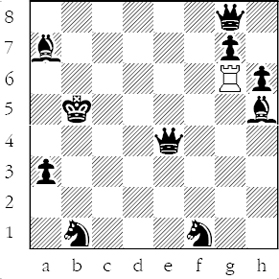
One way to approach the position is to see what’s loose.
Here there are three undefended minor pieces and they all get taken.
1.Rd6 2.Rd7 3.Rxa7 4.Rc7 5.Rc1 6.Rxf1 7.Rf2 8.Rh2 9.Rxh5+

In our next sample Rook Maze, examination reveals that the checking square must be e7. How does the rook get there? Over the dead bodies of the undefended knight and bishop.
Another Rook Maze

1.Ra8 2.Rg8 3.Rg3 4.Rb3 5.Rb4 6.Rxc4 7.Rb4 8.Rxb6 9.Ra6 10.Ra8 11.Rc8 12.Rc7 13.Re7+

A Knight Maze

Here the knight makes a tour of the board, touching all the edges. 1.Nh6 2.Ng4 3.Nf2 4.Nd1 5.Nb2 6.Na4 7.Nb6 8.Nc8 9.Nd6 10.Nb5+

Another Knight Maze

The sole checking square is c7, accessible only through e8 and g7. So the first step is to remove the dark squared bishop. 1.Na2 2.Nc1 3.Nb3 4.Nd2 5.Nf3 6.Ng5 7.Nf7 8.Nxh8. Next the knight retraces its steps in order to reach g7. 9.Nf7 10.Ng5 11.Nh3 12.Nf4 13.Nh5 14.Ng7 15.Ne8 16.Nc7+ Mission accomplished.

Enough examples. By now you get the idea how the Mazes of Chapter One work. Move your maze piece around the board, avoid capture, and check the king, in the fastest way of course. Let’s move on to real chess and...
Multiple Moves
In Chess Mazes we allow only one piece to move. Do we see examples of this in over the board chess? Occasionally we do, mostly in endgames where the pieces have thinned out, but also in other phases of the game as well. There are indeed instances where one piece takes over the action and dominates the proceedings for an extended series of moves.
Our first example, with White to play, features rook moves by Black from the game Morozevich vs. Yakovenko, Pamplona 2006. It’s been a long, tiring game. Here Morozevich could have won by backing the queen out, say 111.Qe5!.

Instead he moved his king up, looking to close on the enemy position. 111.Kf3? Too close as it turned out. Black, operating with the threat of stalemate, is able to offer up his rook, threatening an endless series of checks along the second rank. 111...Rf2+!

112.Ke3 Re2+ 113.Kd3 Rd2+ There’s no escape from the rook checks. If he crosses to the g-file, then ...Rg2 pins the queen. So, Morozevich brought the game to a close. 114.Kxd2 ½-½
Our next example again features Morozevich. This time with the rooks he was more successful.
The opening is from a Winawer French and since we’re still in the opening phase of the game, the following play by White is most unusual. Of his next ten moves, nine are with the rooks.
Morozevich vs. Lputian
Sochi 2007

11.Rb1 0-0-0 12.Rb5 Qa4 13.Qb1 The sole non-rook move in the bunch. 13...Na5 14.Rxc5+ Kb8

15.Rh3 This could be overdoing the rook dance. Instead, Bxh6 is recommended, here or on the next move, before Black plays ...Nf5. As it goes, Black doesn’t get around to ...Nf5, so it all works out well for White. 15...b6 16.Rf3 Ka8 17.Rb5 Nc4 Not 17...Bxb5 18.Bxb5 Qxa3 Bc1 winning. 18.Rb4 Nxa3 19.Rxa4 Nxb1 20.Ra1 We can stop right here. The rook has returned to home base and the sequence comes to an end.
After the further 20...Nxd2 21.Kxd2, White, despite the minus pawn, holds some initiative. As the game went, Black’s passed a-pawn never played a role in the proceedings, and Morozevich went on to win at move forty.
We turn our attention now to extended knight play in the ending.
Grischuk vs. J. Polgar
Biel 2007

Two pawns down, Polgar found an ingenious way to salvage half a point. 61...Ng4! 62.Nd3 62.Nxg4 is stalemate. 62...Nh2+ 63.Ke4 Ng4 If 63...Kxg3 64.Ne5 and Black’s knight has trouble getting back into the game. So for the moment Judit holds off taking at g3. 64.Ne5 Nf6+

65.Kf3 65.Kf5 Kxg3 66.Kxf6 Kxf4, draw: king and knight cannot beat a lone king. 65...Ng4 One more repetition and Black can claim a draw. Grischuk ties another approach. 66.Nc4 Nh2+ 67.Ke4 Nf1 68.Ne3 Nxg3+ 69.Ke5 Kh2 Avoiding 69...Kh4? 70.Nf5+ forcing off the knights. 70.Kd6 Nh5 71.f5 Ng7 72.f6 ½-½

Draw agreed in view of 72...Ne8+ and 73...Nxf6.
Our next example of extended knight play is from the late middlegame, early endgame. This time it is Grischuk’s knight that dominates the play.
White is so tied up defending his queenside that he cannot prevent the knight from cleaning up on the kingside.
Rublevsky vs. Grischuk
Elista 2007

29...Nxh4 30.Rxb2 axb2+ 31.Kb1 Nxg2 32.f5 Nf4 33.fxe6 Nxd3

The knight has made four of the last five moves and is not yet finished. 34.Ba3 Nxe5 35.Kc2 Nc4 36.Bc5 Nd2

This pretty much wraps things up, the knight supporting promotion at b1. 37.a4 b1/Q+ 38.Rxb1 Nxb1 39.a5 Rb5 0-1

We’ve saved the bishop for last, mainly because it’s the laziest piece on the board. Of course it is possible to find extended bishop play in the literature of the game. These happen to be mainly in endgame studies, and we gave a few by Centurini in the original volume of Chess Mazes. But mostly the bishop hangs back. After making a move or two the bishop tends to go into hibernation. Call it lying in wait till a new, favorable opportunity comes along.
Here’s a totally random instance of multiple bishop moves. White is on move.
De la Paz vs. Tiviakov
Meridia 2006

It’s hard to see how White wins. If we remove black’s men he still draws with his king on h8. The bishop is the wrong color for the h-pawn. Nevertheless, White succeeded with seven consecutive bishop moves. 48.Bd3 Kf6 49.Bc4 Kg5 50.Bf1 Kh4 51.Bg2 Be5 52.Bf1 Bd6 53.Bg2 Be5 54.Bf1 Bd6

The bishop moves were getting White nowhere so he moved his king. That decided the game. 55.Kf2 1-0 Don’t look for the answer on the board. Black forfeited on time. Tiviakov registered his displeasure to the arbiter, but to no avail. Them’s the rules.
After this we’ll stay away from over the board chess and close out with two mating problems by Adolph Anderssen. Both feature extended bishop play.
White Mates in Six

1.Bb8 Ka5 2.Bc7+ Ka4 Or 2...b6 3.Bd8 transposing. 3.Bd8 b6 4.Be7 Ka5 Now it’s down to Mate in Two.
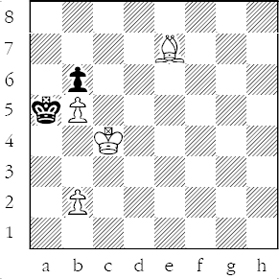
5.Bb4+ Ka4 6.b3#

In the second problem also, the bishop out-tempos the king.
White Mates in Five

1.Bg1 Kc5 2.Bh2 Kd4 3.Bf4 Kc5 4.Bc7 Kd4 5.Bxb6#

Armed as you now are with all this semi-useless information, consider yourself sufficiently warmed up to tackle the main body of Mazes in Chapter One. So go on and tackle them; they don’t tackle back.
#1

#2

#3

#4

#5

#6


#8

#9

#10

#11

#12


#14

#15

#16

#17

#18


#20

#21

#22

#23

#24


#26

#27

#28

#29

#30


#32

#33

#34

#35

#36

#37

#38

#39

#40

#41

#42
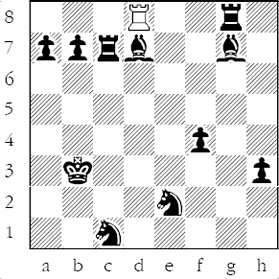

#44

#45

#46
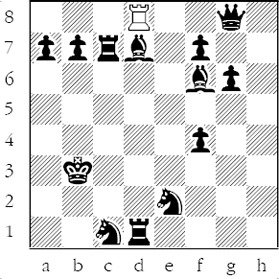
#47

#48


#50

#51

#52

#53

#54

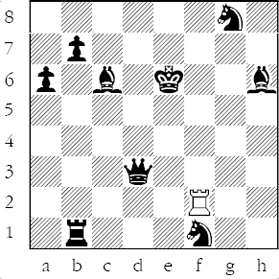
#56

#57

#58

#59

#60


#62

#63

#64

#65

#66


#68

#69
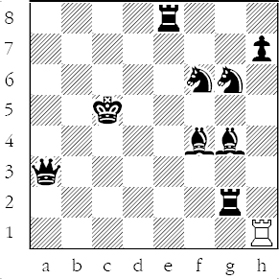
#70

#71

#72

#73
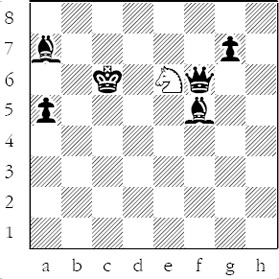
#74

#75

#76

#77
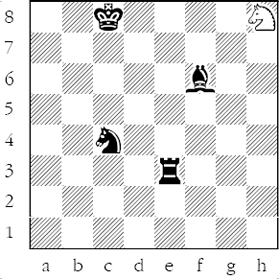
#78


#80

#81

#82

#83

#84
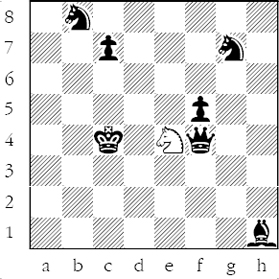

#86

#87

#88

#89

#90


#92

#93

#94

#95

#96


#98

#99

#100

#101

#102


#104

#105

#106

#107
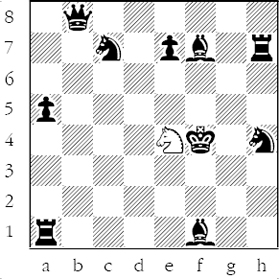
#108
